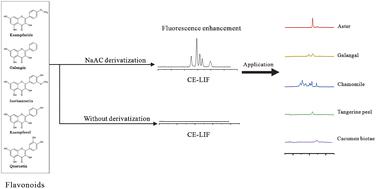当前位置:
X-MOL 学术
›
Anal. Methods
›
论文详情
Our official English website, www.x-mol.net, welcomes your
feedback! (Note: you will need to create a separate account there.)
Fluorescence enhancement of flavonoids and its application in ingredient determination for some traditional Chinese medicines by CE-LIF
Analytical Methods ( IF 2.7 ) Pub Date : 2023-05-17 , DOI: 10.1039/d3ay00486d Shaoyan Zhang 1 , Jinfeng Ning 1 , Qingqing Wang 1 , Wei Wang 1
Analytical Methods ( IF 2.7 ) Pub Date : 2023-05-17 , DOI: 10.1039/d3ay00486d Shaoyan Zhang 1 , Jinfeng Ning 1 , Qingqing Wang 1 , Wei Wang 1
Affiliation

|
Flavonoids are widely used in the treatment of various diseases due to their antioxidant, anti-inflammatory, anticancer and antiviral properties. Fluorescence detection is rarely applied for the determination of flavonoids because of their weak fluorescence. In this work, a method of fluorescence enhancement of flavonoids was firstly introduced by using sodium acetate for flavonoid derivatization. The study discovered that flavonoids, with a hydroxyl at the C3 position, had the ability to emit strong fluorescence after derivatization. Five flavonoids, kaempferide, galangin, isorhamnetin, kaempferol and quercetin, having a special structure, were selected, derivatized and analyzed by capillary electrophoresis with laser-induced fluorescence detection. Under the optimal conditions, the five flavonoids could be completely separated within 3 minutes. Good linear relationships were obtained for all analytes and the limits of detection for the five flavonoids were in the range of 1.18–4.67 × 10−7 mol L−1. Finally, the method was applied to the determination of flavonoids in five traditional Chinese medicines: aster, chamomile, galangal, tangerine peel and cacumen biotae. Flavonoids were successfully found in all these medicines by the developed method. The recoveries were in the range of 84.2–111%. The method developed in this study was fast, sensitive and reliable for the determination of flavonoids.
中文翻译:

黄酮类化合物的荧光增强及其在部分中药成分测定中的CE-LIF应用
黄酮类化合物由于其抗氧化、抗炎、抗癌和抗病毒特性而被广泛用于治疗各种疾病。由于其荧光较弱,荧光检测很少应用于黄酮类化合物的测定。本工作首次提出了利用乙酸钠进行黄酮类衍生化来增强黄酮类化合物荧光的方法。研究发现,C3位带有羟基的黄酮类化合物,在衍生化后具有发出强荧光的能力。采用毛细管电泳和激光诱导荧光检测技术,筛选、衍生化并分析了具有特殊结构的五种黄酮类化合物:山奈素、高良姜素、异鼠李素、山奈酚和槲皮素。在最佳条件下,5种黄酮类化合物可在3分钟内完全分离。-7摩尔L -1。最后将该方法应用于紫菀、洋甘菊、高良姜、陈皮、黑果5种中药材中黄酮类成分的测定。通过所开发的方法,在所有这些药物中成功地发现了类黄酮。回收率在 84.2-111% 范围内。本研究开发的方法快速、灵敏、可靠,可用于黄酮类化合物的测定。
更新日期:2023-05-17
中文翻译:

黄酮类化合物的荧光增强及其在部分中药成分测定中的CE-LIF应用
黄酮类化合物由于其抗氧化、抗炎、抗癌和抗病毒特性而被广泛用于治疗各种疾病。由于其荧光较弱,荧光检测很少应用于黄酮类化合物的测定。本工作首次提出了利用乙酸钠进行黄酮类衍生化来增强黄酮类化合物荧光的方法。研究发现,C3位带有羟基的黄酮类化合物,在衍生化后具有发出强荧光的能力。采用毛细管电泳和激光诱导荧光检测技术,筛选、衍生化并分析了具有特殊结构的五种黄酮类化合物:山奈素、高良姜素、异鼠李素、山奈酚和槲皮素。在最佳条件下,5种黄酮类化合物可在3分钟内完全分离。-7摩尔L -1。最后将该方法应用于紫菀、洋甘菊、高良姜、陈皮、黑果5种中药材中黄酮类成分的测定。通过所开发的方法,在所有这些药物中成功地发现了类黄酮。回收率在 84.2-111% 范围内。本研究开发的方法快速、灵敏、可靠,可用于黄酮类化合物的测定。

















































 京公网安备 11010802027423号
京公网安备 11010802027423号